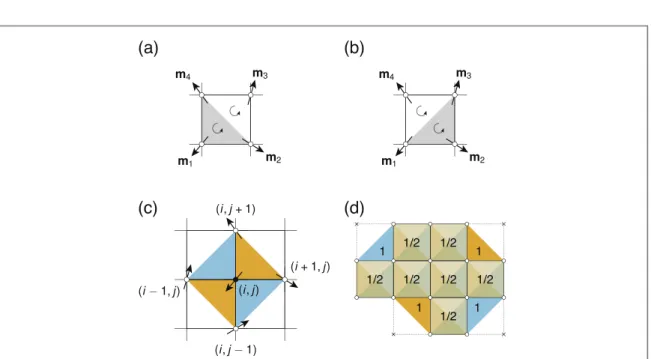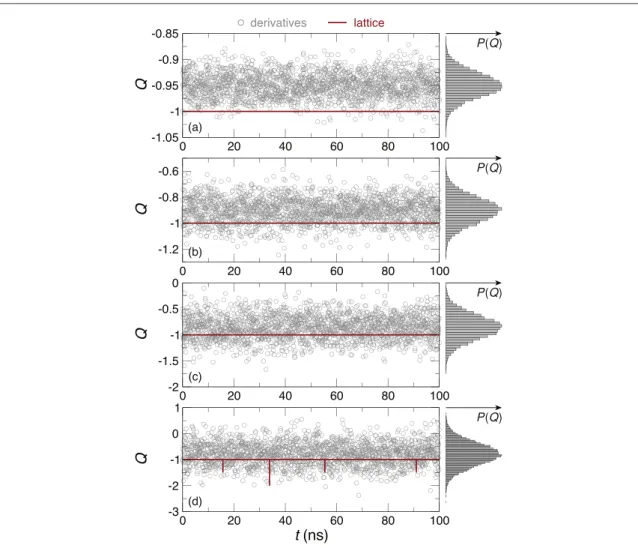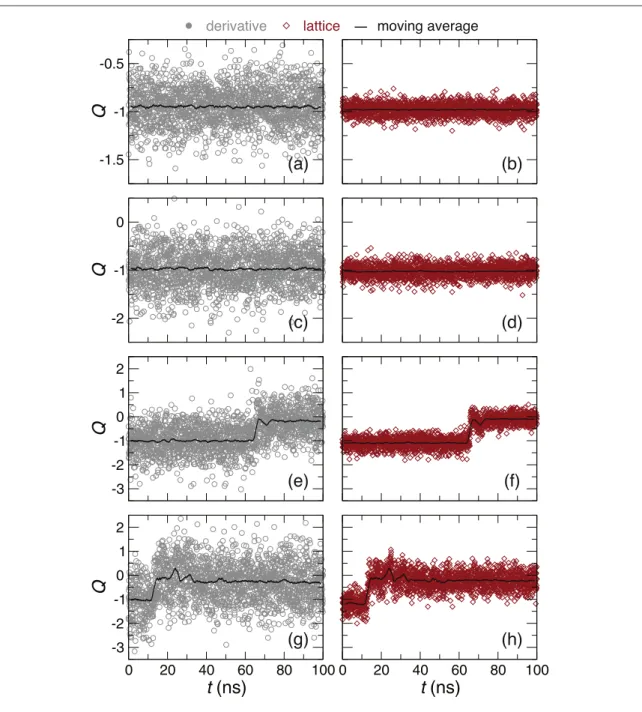HAL Id: hal-03005541
https://hal.archives-ouvertes.fr/hal-03005541
Submitted on 14 Nov 2020
HAL is a multi-disciplinary open access
archive for the deposit and dissemination of
sci-entific research documents, whether they are
pub-lished or not. The documents may come from
teaching and research institutions in France or
abroad, or from public or private research centers.
L’archive ouverte pluridisciplinaire HAL, est
destinée au dépôt et à la diffusion de documents
scientifiques de niveau recherche, publiés ou non,
émanant des établissements d’enseignement et de
recherche français ou étrangers, des laboratoires
publics ou privés.
On quantifying the topological charge in micromagnetics
using a lattice-based approach
Joo-Von Kim, Jeroen Mulkers
To cite this version:
Joo-Von Kim, Jeroen Mulkers. On quantifying the topological charge in micromagnetics using a
lattice-based approach. IOP SciNotes, 2020, 1 (2), pp.025211. �10.1088/2633-1357/abad0c�.
�hal-03005541�
IOP SciNotes 1 (2020) 025211 https://doi.org/10.1088/2633-1357/abad0c
ARTICLE
On quantifying the topological charge in micromagnetics using a
lattice-based approach
Joo-Von Kim1 and Jeroen Mulkers2
1 Centre de Nanosciences et de Nanotechnologies, CNRS, Université Paris-Saclay, 91120 Palaiseau, France 2 Department of Solid State Sciences, Ghent University, 9000 Ghent, Belgium
E-mail:joo-von.kim@c2n.upsaclay.fr
Keywords: micromagnetics, skyrmion charge, skyrmions
Abstract
An implementation of a lattice-based approach for computing the topological skyrmion charge is
provided for the open source micromagnetics code
MUMAX3. Its accuracy with respect to an existing
method based on finite difference derivatives is compared for three different test cases. The
lattice-based approach is found to be more robust for finite-temperature dynamics and for nucleation and
annihilation processes in extended systems.
1. Introduction
The topological charge or skyrmion number associated with an O(3) field, m r( ) 1, is given by
Q d x x y m m m 1 4 . 1 2 ⎛ ⎝ ⎜ ⎞ ⎠ ⎟ · ( )
This quantity is used to characterize the topology of spin textures such as vortices and skyrmions in two-dimensional systems (see, e.g., [1]), where m represents the orientation of the magnetic moments. When m(r) is projected onto the unit sphere, Q measures the number of times the moments wrap around the surface of this sphere. For vortices and merons, Q=±1/2, while for skyrmions, Q=±1. Higher-order half- and full-integer charges are also possible. In numerical micromagnetism, a common approach involves discretising m(r, t) using the method of finite differences [2–4]. The underlying assumption is that cell-to-cell variations in m are
sufficiently small such that the exchange energy, approximated to lowest order as( m)2, remains meaningful.
Issues can arise under certain conditions, such as in the nucleation and annihilation of vortices and
skyrmions, or in the stochastic dynamics with random fields, where large spatial variations in m can occur which reduce the accuracy of the finite-difference approximations of equation (1) and result in nonphysical values of Q. Consider an isolated skyrmion. Figure1(a) shows the equilibrium profile computed with theMUMAX3code [4] and the parameters in [5]. The corresponding map of m onto the unit sphere is given in figure1(b), where
dots represent the orientations of m and the lines indicate bonds between nearest-neighbour finite difference cells [6,7]. The entirety of the sphere is covered by this mesh, which remains intact everywhere and reflects the fact that the spin texture in figure1(a) possesses a nontrivial topology. Equation (1) gives Q=−0.99978290 for this configuration, which is acceptably close to the theoretical value of Q=−1. Consider now the effect of disorder, e.g., due to thermal fluctuations, where each moment is deviated away randomly from its equilibrium orientation in figure1(a), as shown in figure1(c). The corresponding map onto the unit sphere for this
disordered case is presented in figure1(d). While the mesh appears distorted, it retains the same topology as the case in figure1(b) and therefore possess an identical charge. However equation (1) gives Q=−0.97115153 in this case, which reflects a loss in accuracy of the finite difference derivatives.
In this note, we discuss a lattice-based approach for computing Q that does not require rely on spatial derivatives. We discuss an implementation of this scheme for finite difference micromagnetics and provide three examples against which this implementation is tested.
OPEN ACCESS RECEIVED
12 June 2020
REVISED
26 July 2020
ACCEPTED FOR PUBLICATION
6 August 2020
PUBLISHED
28 August 2020
Original content from this work may be used under the terms of theCreative Commons Attribution 4.0 licence.
Any further distribution of this work must maintain attribution to the author(s) and the title of the work, journal citation and DOI.
2. Lattice-based implementation for finite difference schemes
We follow the approach of Berg and Lüscher [8], which has been employed in atomistic spin dynamics and
Monte Carlo simulations [9,10]. Consider the four moments in figure2(a), each of which represent the average magnetization orientation in a finite difference cell. We treat these moments as lattice spins and set aside all aspects related to the interactions between them. Figure2(a) represents one unit cell of this lattice. The
topological charge is given by the sum over the ensemble of elementary signed triangles qijkon the unit sphere,
Figure 1. (a) Configuration of a magnetic skyrmion at zero temperature, where the colour code indicates the value of mz. (b) Projection of m(r) in (a) onto the unit sphere. The view is from the z axis toward +z. (c) Example of disordered m occurring at finite
temperatures. (d) Projection of m(r) in (c) onto the unit sphere.
Figure 2. Lattice scheme for computing the topological charge. (a) Two signed triangles, q124and q234, make up the unit cell. (b) Alternative definition of the signed triangles. (c) Scheme for the local charge density at site (i, j) by averaging over the two unit cells spanned by the signed triangles constructed with the nearest neighbours. (d) Scheme for an arbitrary finite-size geometry, where numbers indicate weights and crosses indicate vacant sites.
2
Q 1 q 4 ijk ijk, ( )2 where q m m m m m m m m m tan 2 1 , 3 ijk i j k i j i k j k ⎜ ⎟ ⎛ ⎝ ⎞⎠ · · ( · ) · ( )
which is invariant under a cyclic permutation of the indices ijk. Figure2(a) shows two of such signed triangles
that make up the unit cell, q124(grey) and q234(white). Figure2(b) represents another definition that is equally
valid. ijk in equation (2) indicates that the summation is restricted to unique triangles as shown in figures2(a) or2(b).
Figure2(c) illustrates a variation of this scheme that allows a local charge density analogous to equation (1) to be defined at a site i j( ), which is commensurate with the coordinates of the finite difference cells in which m, i j, is
defined. The method involves averaging over the two unit cells comprising the four triangles spanned by (i, j) with its nearest-neighbour spins, (i+1, j), (i, j+1), (i−1, j), and (i, j−1). This approach uses both of the conventions in figures2(a) and (b), and takes the average of the two, thereby assigning a weight of 1/2 to each triangle qijk. For finite-sized systems, the same averaging procedure cannot be applied at curved boundary edges
because not all signed triangles are present, i.e., only one of the definitions, figure2(a) or figure2(b), produces the necessary orientation to cover the three spins that comprise the boundary, e.g., the blue triangles in the top left and bottom right of figure2(d). In such cases, we assign a weight of 1 to the isolated signed triangle.
We provide an implementation of this method forMUMAX3through the extension
ext_topologicalchargelattice which is publicly available inMUMAX3.10[11]. This extension provides a local charge density at site (i, j) in units of m−2, analogous to the quantity provided by the finite-difference implementation of equation (1) through the extensionext_topologicalcharge, which is obtained by dividing the qijkby the surface area of the unit cell.
3. Simulation examples with the lattice-based approach
3.1. Isolated skyrmion at finite temperatures with periodic boundary conditions
Consider an isolated ferromagnetic skyrmion in a 200×200×0.6 nm film, discretised with 256×256× 1 finite difference cells, with periodic boundary conditions in the film plane. We use an exchange constant of A=16 pJ m−1, a saturation magnetisation of Ms=1.1 MA m−1, a perpendicular magnetic anisotropy
constant of Ku=0.54 MJ m−3, an interfacial Dzyaloshinskii-Moriya interaction (DMI) constant of
D=2.7 mJ m−2, and a Gilbert damping of α=0.3. These parameters model a three monolayer-thick Co film with a Curie temperature of 550 K [12]. Dipolar interactions are neglected for simplicity. The evolution of Q(t) over 100ns is presented in figure3for four different temperatures, where an adaptive time-step integration method is used to solve the stochastic Landau–Lifshitz equation [13]. Q is computed at 5ps intervals using finite difference derivatives (equation (1)) as implemented by the existing ext_topologicalcharge extension in
MUMAX3, and with the lattice-based implementation in ext_topologicalchargelattice. Large fluctuations are seen in the Q(t) computed with finite difference derivatives, whose distribution spreads as the temperature increases as shown by the histograms in figure3. Moreover the time-averaged Q obtained, which coincides with the peaks in the distribution function P(Q), does not coincide with the expected value of −1. On the other hand the lattice-based approach gives a near-constant value of Q over the range of temperatures and times simulated, where fluctuations (not visible) are mainly related to the limits of the single-precision floating-point arithmetic (e.g., Q=−1.0000001, −1.0000004, −1.0000008, −1.0000002, and −0.9999996 over 20-ns intervals at T=400 K). Deviations from Q=−1 can be detected at 400 K with the lattice-based approach, where transient −1/2 and −1 states are also seen in figure3. These represent thermally-driven nucleation and annihilation of meron and skyrmion states, respectively.
3.2. Soliton pair generation in a ferromagnetic track
We turn our attention to nucleation of skyrmion-antiskyrmion pairs due to spin-transfer torques [14,15]. The
geometry comprises a 1000×125×0.6 nm film with the same magnetic parameters as in section3.1, except for D=0.1 mJ m−2and α=0.05. A nucleation zone is defined by a 25-nm diameter circular region of the track, in which the uniaxial anisotropy is oriented along y instead with Ku=0.5 MJ m−3. A conventional
current flows along xwith a density of 25 TA m−2and a spin polarisation of P=1, with nonadiabatic terms being neglected. The spin-transfer torques, combined with the nonuniform effective fields seen at the nucleation zone, result in skyrmion-antiskyrmion pairs being shed from this site, which then undergo Kelvin motion and propagate along the x direction before separating and annihilating.
Figure4presents Q(t) and snapshots of the micromagnetic state. Four different cell sizes are considered to test the relative accuracy of equation (1) with respect to equations (2) and (3). For the smallest (figure4(a)), there
is good agreement between the two methods where only a handful of points with noninteger Q are obtained with equation (1), which occur at the transitions involving the nucleation and annihilation of (anti)skyrmions. As the
cell size is increased (figures4(b)–(d)), a greater number of noninteger Q is obtained with equation (1), with smooth variations observed in figures4(c) and4(d). Meanwhile, the lattice-based approach provides clear plateaus in Q close to integer values for all cases, which suggests that the smooth variations in noninteger Q are related to the loss in accuracy of the finite difference derivatives. The nucleation events differ between the four cases because the circular nucleation zone is discretised differently. Figure4(e) shows snapshots of the micromagnetic state at different instances where nucleation, Kelvin motion of skyrmion-antiskyrmion pairs, and (anti)skyrmion annihilation can be seen.
3.3. Isolated skyrmion in confined structures at finite temperatures
In systems with DMI, boundary edges result in a tilt in the background magnetization away from the z-axis, even in a nominally uniformly-magnetized state, as a result of chiral boundary conditions [16,17]. The tilt orientation is determined by the sign of D and the resulting Q can take on noninteger values. We consider a disc, 200 nm in diameter and 0.6 nm in thickness, which is discretised with 256×256×1 finite difference cells (all other magnetic parameters are identical to those in section3.1). A disc with an isolated skyrmion at T=0 K is found to give Q of −0.9304853 using ext_topologicalcharge and −0.9468352 using ext_topologicalchargelattice. Deviations from Q=−1 represent the contribution from the edge magnetization tilts.
Q(t) for this disc is shown in figure5for four different temperatures. In contrast to figure3, both the derivative- and lattice-based methods give fluctuations in Q, albeit to a lesser extent for the latter. Based on the results above, the variations in Q seen with the lattice-based method in figure5can be attributed to the thermal fluctuations of the edge magnetization states. Boundary edges also facilitate annihilation of the isolated
Figure 3. Comparison of Q t( ) computed with equation (1) (‘derivative’) and with equations (2) and (3) (‘lattice’) at different temperatures: (a) 100 K, (b) 200 K, (c) 300 K, and (d) 400 K. The right inset shows the histogram of the 2×104points for Q obtained with equation (1).
4
skyrmion, which can be seen at T=300 and 400 K (figures5(e)–(h), respectively), as evidenced by a sharp transition in the time-averaged curves toward Q=0. Minor oscillations in these time-averaged curves also appear, which result from partially-reversed states at the boundaries that occur during the annihilation process. This example shows that deviations from noninteger (and non half-integer) values of Q can be expected in confined structures when nucleation and annihilation of topological charges take place, in the presence of thermal fluctuations with chiral boundary conditions, or both.
4. Conclusion
Spurious variations in the topological charge due to inaccuracies in finite-difference derivatives can be mitigated by using a lattice-based approach, for which we provide an implementation for theMUMAX3micromagnetics code. While the results do not necessarily call into question the validity of published work (since the topological
Figure 4. Generation of skyrmion-antiskyrmion pairs due to spin-transfer torques. Q(t) in a 1000×125×0.6 nm track, with different finite difference discretisation in the film plane: (a) 1024×128, (b) 768×96, (c) 512×64, and (d) 384×48 cells. All systems are 1 cell thick. (e) Snapshots of the micromagnetic state at four instances for the discretisation in (a). The vertical dashed lines in (a) correspond to the snapshots in (e). J indicates the conventional current, v the direction of Kelvin motion of the nucleated pairs, and the circle indicates the nucleation zone.
charge is often used as a proxy for magnetization gradients), they do highlight the care with which noninteger values of Q(t) should be interpreted, particularly when processes such as nucleation, annihilation, and thermal fluctuations are at play.
Acknowledgments
This work was partially supported by the Agence Nationale de la Recherche under contract no. ANR-17-CE24-0025 (TOPSKY) and Fonds WetenschappelijkOnderzoek (FWO-Vlaanderen) through Project No. G098917N.
Data availability statement
The data that support the findings of this study are available upon reasonable request from the authors.
Figure 5. Comparison of Q(t) computed with equation (1) (‘derivative’) and with equations (2) and (3) (‘lattice’) at different temperatures: (a), (b) 100 K, (c), (d) 200 K, (e), (f) 300 K, and (g), (h) 400 K. The solid black line represents a moving time average computed with a 1-ns window.
6
ORCID iDs
Joo-Von Kim https://orcid.org/0000-0002-3849-649X
Jeroen Mulkers https://orcid.org/0000-0002-4000-9275
References
[1] Braun H B 2012 Adv. Phys.61 1–116
[2] Miltat J E and Donahue M J 2007 Numerical Micromagnetics: Finite Difference Methods Handbook of Magnetism and Advanced Magnetic Materials ed H Kronmüller and S Parkin vol 2 (New York: Wiley) (https://doi.org/10.1002/9780470022184.hmm202) [3] Donahue M J and Porter D G 1999 OOMMF User’s Guide, Version 1.0 Tech. rep. National Institute of Standards and Technology
Gaithersburg, MD
[4] Vansteenkiste A, Leliaert J, Dvornik M, Helsen M, Garcia-Sanchez F and Van Waeyenberge B 2014 AIP Adv.4 107133
[5] Kim J V and Yoo M W 2017 Appl. Phys. Lett.110 132404
[6] Rohart S, Miltat J and Thiaville A 2016 Phys. Rev. B93 214412
[7] Desplat L, Kim J V and Stamps R L 2019 Phys. Rev. B99 174409
[8] Berg B and Lüscher M 1981 Nucl. Phys.190 412–24
[9] Böttcher M, Heinze S, Egorov S, Sinova J and Dupé B 2019 New J. Phys.20 103014
[10] Müller G P, Hoffmann M, Dißelkamp C, Schürhoff D, Mavros S, Sallermann M, Kiselev N S, Jónsson H and Blügel S 2019 Phys. Rev. B
99 224414
[11]https://mumax.github.io
[12] Schneider C M, Bressler P, Schuster P, Kirschner J, de Miguel J J and Miranda R 1990 Phys. Rev. Lett.64 1059–62
[13] Leliaert J, Mulkers J, De Clercq J, Coene A, Dvornik M and Van Waeyenberge B 2017 AIP Adv.7 125010
[14] Stier M, Häusler W, Posske T, Gurski G and Thorwart M 2017 Phys. Rev. Lett.118 267203
[15] Everschor-Sitte K, Sitte M, Valet T, Abanov A and Sinova J 2018 New J. Phys.19 092001
[16] Rohart S and Thiaville A 2013 Phys. Rev. B88 184422
[17] Garcia-Sanchez F, Borys P, Vansteenkiste A, Kim J V and Stamps R L 2014 Phys. Rev. B89 224408



